Frost Resilience of Stabilized Earth Building Materials
Abstract
:1. Introduction
2. Methods
2.1. Theoretical Development
2.1.1. Ice Segregation and Frost Damage
2.1.2. Frost Cracking Thresholds during Unsaturated Conditions
2.2. Materials
2.3. Temperature and Moisture Time Series
3. Results and Discussion
3.1. Environmental Conditions, Material Properties, and Saturated Damage
3.2. Environmental Conditions, Material Properties, and Unsaturated Damage
3.3. Damage Variations between Different Cities
3.4. Changing Damage Patterns over Time
3.5. Interpreting the Damage Index
4. Conclusions
Author Contributions
Funding
Conflicts of Interest
Appendix A
| Symbol | Description |
|---|---|
| c | heat capacity—see Table 1 |
| C | water transport parameter—see Table 1 & Equation (2) |
| permeability under liquid saturated conditions—see Table 1 | |
| dry thermal conductivity—see Table 1 | |
| L | latent heat of fusion (≈3.3 × 10 J/kg) |
| n | porosity—see Table 1 |
| damage index for saturated conditions—see Equation (1) | |
| damage index for unsaturated conditions—from Equation (1) with in place of | |
| pressure difference between ice and liquid—see Equation (4) | |
| gas constant ( J/(mol K)) | |
| relative humidity | |
| S | total water content |
| liquid saturation level | |
| t | time |
| T | temperature |
| maximum temperature for saturated frost damage—see Table 1 | |
| maximum temperature for unsaturated frost damage—see Equation (7) | |
| dry bulb temperature | |
| bulk melting temperature (≈273 K) | |
| temperature of first pore ice formation—see Table 1 | |
| partial molar volume of water ( m/mol) | |
| z | depth into wall—measured from exterior surface |
| exponent in permeability relation—see Table 1 | |
| exponent in freezing curve—see Table 1 & Equation (6) | |
| surface energy of ice-liquid interface (≈0.033 J/m) | |
| surface energy of vapor-liquid interface (≈0.074 J/m) | |
| ratio of —adopted nominal value: 8 | |
| vapor diffusion resistance factor—see Table 1 | |
| water density (≈10 kg/m) | |
| dry material density—see Table 1 | |
| matric potential—see Equation (3) | |
| water viscosity (≈1.8 × 10 Pa s) |
| City | Concrete | Compressed Stabilized Earth Blocks | Stabilized Rammed Earth | Solid Brick Masonry |
|---|---|---|---|---|
| Golden (%) | 0.074 (0.080) | 0.063 (0.051) | 0.069 (0.056) | 0.0064 (0.0049) |
| () | 1.1 (0) | 0.80 (0) | 0.64 (0.13) | 0.016 (0) |
| Tongliao (%) | 0.21 (0.21) | 0.12 (0.12) | 0.13 (0.13) | 0.011 (0.012) |
| () | 0 (0) | 0.10 (0.78) | 0.45 (2.6) | 0 (0.11) |
| Philadelphia (%) | 0.061 (0.056) | 0.043 (0.040) | 0.046 (0.042) | 0.0049 (0.0046) |
| () | 0.92 (0.080) | 1.3 (0.035) | 3.0 (0.088) | 0.15 (0.0093) |
| Copenhagen (%) | 0.0084 (0.014) | 0.017 (0.014) | 0.019 (0.014) | 0.0019 (0.0015) |
| () | 0 (0) | 0 (0.39) | 0.029 (2.8) | 0 (0.17) |
| Stockholm (%) | 0.066 (0.12) | 0.038 (0.064) | 0.037 (0.062) | 0.0034 (0.0061) |
| () | 0 (0.46) | 0.046 (9.4) | 0.69 (29) | 0.0012 (2.0) |
| Ankara (%) | 0.020 (0) | 0.023 (0.0072) | 0.026 (0.0066) | 0.0024 (0.00095) |
| () | 0 (0) | 0 (0) | 0 (0) | 0 (0) |
| Toronto (%) | 0.15 (0.097) | 0.087 (0.087) | 0.087 (0.096) | 0.0082 (0.0093) |
| () | 0.13 (0) | 0.26 (0.60) | 3.5 (10) | 0.24 (0.12) |
| Helsinki (%) | 0.074 (0.14) | 0.057 (0.082) | 0.059 (0.077) | 0.0054 (0.0071) |
| () | 0 (2.6) | 0.33 (6.4) | 0.68 (20) | 0.0082 (1.8) |
| Montreal (%) | 0.18 (0.15) | 0.10 (0.10) | 0.10 (0.11) | 0.0094 (0.010) |
| () | 1.6 (0.80) | 2.7 (0.62) | 4.0 (0.87) | 0.0067 (0.013) |
| Oslo (%) | 0.031 (0) | 0.044 (0) | 0.046 (0) | 0.0050 (0) |
| () | 0 (0) | 0.38 (0) | 0.62 (0) | 0.0030 (0) |
| Winnipeg (%) | 0.14 (0.17) | 0.081 (0.10) | 0.079 (0.10) | 0.0072 (0.0095) |
| () | 0.56 (0.30) | 1.5 (2.6) | 4.5 (6.5) | 0.21 (0.28) |
| Anchorage (%) | 0.14 (0.09) | 0.096 (0.067) | 0.10 (0.069) | 0.0098 (0.0065) |
| () | 0 (0) | 0.0018 (0.099) | 0.24 (0.58) | 0 (0) |
References
- Hasanbeigi, A.; Price, L.; Lin, E. Emerging energy-efficiency and CO2 emission-reduction technologies for cement and concrete production: A technical review. Renew. Sustain. Energy Rev. 2012, 16, 6220–6238. [Google Scholar] [CrossRef]
- Kariyawasam, K.; Jayasinghe, C. Cement stabilized rammed earth as a sustainable construction material. Constr. Build. Mater. 2016, 105, 519–527. [Google Scholar] [CrossRef]
- Reddy, B.V.; Kumar, P.P. Embodied energy in cement stabilised rammed earth walls. Energy Build. 2010, 42, 380–385. [Google Scholar] [CrossRef]
- Cabeza, L.F.; Barreneche, C.; Miró, L.; Morera, J.M.; Bartolí, E.; Fernández, A.I. Low carbon and low embodied energy materials in buildings: A review. Renew. Sustain. Energy Rev. 2013, 23, 536–542. [Google Scholar] [CrossRef]
- Reddy, B.V.; Jagadish, K. Embodied energy of common and alternative building materials and technologies. Energy Build. 2003, 35, 129–137. [Google Scholar] [CrossRef]
- Cristelo, N.; Glendinning, S.; Miranda, T.; Oliveira, D.; Silva, R. Soil stabilisation using alkaline activation of fly ash for self compacting rammed earth construction. Constr. Build. Mater. 2012, 36, 727–735. [Google Scholar] [CrossRef] [Green Version]
- Silva, R.A.; Oliveira, D.V.; Miranda, T.; Cristelo, N.; Escobar, M.C.; Soares, E. Rammed earth construction with granitic residual soils: The case study of northern Portugal. Constr. Build. Mater. 2013, 47, 181–191. [Google Scholar] [CrossRef] [Green Version]
- Windstorm, B.; Schmidt, A. A report of contemporary rammed earth construction and research in North America. Sustainability 2013, 5, 400–416. [Google Scholar] [CrossRef]
- Fagone, M.; Loccarini, F.; Ranocchiai, G. Strength evaluation of jute fabric for the reinforcement of rammed earth structures. Compos. Part B Eng. 2017, 113, 1–13. [Google Scholar] [CrossRef]
- da Rocha, C.G.; Consoli, N.C.; Johann, A.D.R. Greening stabilized rammed earth: Devising more sustainable dosages based on strength controlling equations. J. Clean. Prod. 2014, 66, 19–26. [Google Scholar] [CrossRef]
- Hall, M.; Djerbib, Y. Moisture ingress in rammed earth: Part 2—The effect of soil particle-size distribution on the absorption of static pressure-driven water. Constr. Build. Mater. 2006, 20, 374–383. [Google Scholar] [CrossRef]
- Allinson, D.; Hall, M. Humidity buffering using stabilised rammed earth materials. Proc. Inst. Civ. Eng.-Constr. Mater. 2012, 165, 335–344. [Google Scholar] [CrossRef] [Green Version]
- McGregor, F.; Heath, A.; Fodde, E.; Shea, A. Conditions affecting the moisture buffering measurement performed on compressed earth blocks. Build. Environ. 2014, 75, 11–18. [Google Scholar] [CrossRef] [Green Version]
- Brambilla, A.; Jusselme, T. Preventing overheating in offices through thermal inertial properties of compressed earth bricks: A study on a real scale prototype. Energy Build. 2017, 156, 281–292. [Google Scholar] [CrossRef]
- Balaguer, L.; Vegas López-Manzanares, F.; Mileto, C.; García-Soriano, L. Assessment of the thermal behaviour of rammed earth walls in the summer period. Sustainability 2019, 11, 1924. [Google Scholar] [CrossRef]
- Rempel, A.R.; Rempel, A.W. Rocks, clays, water, and salts: Highly durable, infinitely rechargeable, eminently controllable thermal batteries for buildings. Geosci. Spec. Issue Geosci. Built Environ. 2013, 3, 63–101. [Google Scholar] [CrossRef]
- Dixon, R.K.; McGowan, E.; Onysko, G.; Scheer, R.M. US energy conservation and efficiency policies: Challenges and opportunities. Energy Policy 2010, 38, 6398–6408. [Google Scholar] [CrossRef]
- Buyle, M.; Braet, J.; Audenaert, A. Life cycle assessment in the construction sector: A review. Renew. Sustain. Energy Rev. 2013, 26, 379–388. [Google Scholar] [CrossRef]
- Pacheco-Torgal, F.; Faria, J.; Jalali, S. Embodied energy versus operational energy. Showing the shortcomings of the energy performance building directive (EPBD). Mater. Sci. Forum 2013, 730, 587–591. [Google Scholar] [CrossRef]
- Cabeza, L.F.; Rincón, L.; Vilariño, V.; Pérez, G.; Castell, A. Life cycle assessment (LCA) and life cycle energy analysis (LCEA) of buildings and the building sector: A review. Renew. Sustain. Energy Rev. 2014, 29, 394–416. [Google Scholar] [CrossRef]
- Rauf, A.; Crawford, R.H. Building service life and its effect on the life cycle embodied energy of buildings. Energy 2015, 79, 140–148. [Google Scholar] [CrossRef]
- Wolkoff, P. Indoor air humidity, air quality, and health—An overview. Int. J. Hyg. Environ. Health 2018, 221, 376–390. [Google Scholar] [CrossRef] [PubMed]
- Gallipoli, D.; Bruno, A.W.; Perlot, C.; Mendes, J. A geotechnical perspective of raw earth building. Acta Geotech. 2017, 12, 463–478. [Google Scholar] [CrossRef] [Green Version]
- Khadka, B.; Shakya, M. Comparative compressive strength of stabilized and un-stabilized rammed earth. Mater. Struct. 2016, 49, 3945–3955. [Google Scholar] [CrossRef]
- Bernat-Maso, E.; Gil, L.; Escrig, C. Textile-reinforced rammed earth: Experimental characterisation of flexural strength and thoughness. Constr. Build. Mater. 2016, 106, 470–479. [Google Scholar] [CrossRef]
- Jaquin, P.; Augarde, C.; Gallipoli, D.; Toll, D. The strength of unstabilised rammed earth materials. Géotechnique 2009, 59, 487–490. [Google Scholar] [CrossRef] [Green Version]
- Miccoli, L.; Müller, U.; Fontana, P. Mechanical behaviour of earthen materials: A comparison between earth block masonry, rammed earth and cob. Constr. Build. Mater. 2014, 61, 327–339. [Google Scholar] [CrossRef]
- Ciancio, D.; Beckett, C.; Carraro, J. Optimum lime content identification for lime-stabilised rammed earth. Constr. Build. Mater. 2014, 53, 59–65. [Google Scholar] [CrossRef]
- Touré, P.M.; Sambou, V.; Faye, M.; Thiam, A.; Adj, M.; Azilinon, D. Mechanical and hygrothermal properties of compressed stabilized earth bricks (CSEB). J. Build. Eng. 2017, 13, 266–271. [Google Scholar] [CrossRef]
- Sindanne, S.A.; Ntamack, G.E.; Sanga, R.P.L.; Moubeke, C.A.; Sallaboui, E.S.K.; Bouabid, H.; Mansouri, K.; D’ouazzane, S.C. Thermophysical characterization of earth blocks stabilized by cement, sawdust and lime. J. Build. Mater. Struct. 2014, 1, 58–64. [Google Scholar]
- Mandley, S.; Harmsen, R.; Worrell, E. Identifying the potential for resource and embodied energy savings within the UK building sector. Energy Build. 2015, 86, 841–851. [Google Scholar] [CrossRef]
- Malmqvist, T.; Nehasilova, M.; Moncaster, A.; Birgisdottir, H.; Rasmussen, F.N.; Wiberg, A.H.; Potting, J. Design and construction strategies for reducing embodied impacts from buildings—Case study analysis. Energy Build. 2018, 166, 35–47. [Google Scholar] [CrossRef]
- Lützkendorf, T.; Foliente, G.; Balouktsi, M.; Wiberg, A.H. Net-zero buildings: Incorporating embodied impacts. Build. Res. Inf. 2015, 43, 62–81. [Google Scholar] [CrossRef]
- Sharma, V.; Marwaha, B.M.; Vinayak, H.K. Enhancing durability of adobe by natural reinforcement for propagating sustainable mud housing. Int. J. Sustain. Built Environ. 2016, 5, 141–155. [Google Scholar] [CrossRef] [Green Version]
- Illampas, R.; Ioannou, I.; Charmpis, D.C. Overview of the pathology, repair and strengthening of adobe structures. Int. J. Archit. Herit. 2013, 7, 165–188. [Google Scholar] [CrossRef]
- Heathcote, K. Durability of earthwall buildings. Constr. Build. Mater. 1995, 9, 185–189. [Google Scholar] [CrossRef]
- Hall, M.; Djerbib, Y. Moisture ingress in rammed earth: Part 1—The effect of soil particle-size distribution on the rate of capillary suction. Constr. Build. Mater. 2004, 18, 269–280. [Google Scholar] [CrossRef]
- Swan, A.J.; Rteil, A.; Lovegrove, G. Sustainable earthen and straw bale construction in North American buildings: Codes and practice. J. Mater. Civ. Eng. 2011, 23, 866–872. [Google Scholar] [CrossRef]
- Muntohar, A.S. Engineering characteristics of the compressed-stabilized earth brick. Constr. Build. Mater. 2011, 25, 4215–4220. [Google Scholar] [CrossRef]
- Beckett, C.; Ciancio, D. Durability of cement-stabilised rammed earth: A case study in Western Australia. Aust. J. Civ. Eng. 2016, 14, 54–62. [Google Scholar] [CrossRef]
- Obonyo, E.; Exelbirt, J.; Baskaran, M. Durability of compressed earth bricks: Assessing erosion resistance using the modified spray testing. Sustainability 2010, 2, 3639–3649. [Google Scholar] [CrossRef]
- Pakkala, T.A.; Köliö, A.; Lahdensivu, J.; Kiviste, M. Durability demands related to frost attack for Finnish concrete buildings in changing climate. Build. Environ. 2014, 82, 27–41. [Google Scholar] [CrossRef]
- Bonshor, R.B.; Bonshor, L.L.; Sadgrove, R. Cracking in Buildings; Construction Research Communications Limited: London, UK, 1996. [Google Scholar]
- Lourenço, P.B.; van Hees, R.; Fernandes, F.; Lubelli, B. Characterization and damage of brick masonry. In Structural Rehabilitation of Old Buildings; Springer: Berlin/Heidelberg, Germany, 2014; pp. 109–130. [Google Scholar]
- Brimblecombe, P.; Grossi, C.M. Damage to buildings from future climate and pollution. APT Bull. J. Preserv. Technol. 2007, 38, 13–18. [Google Scholar]
- Grossi, C.M.; Brimblecombe, P.; Harris, I. Predicting long term freeze–thaw risks on Europe built heritage and archaeological sites in a changing climate. Sci. Total Environ. 2007, 377, 273–281. [Google Scholar] [CrossRef] [PubMed]
- Davidson, G.; Nye, J. A photoelastic study of ice pressure in rock cracks. Cold Reg. Sci. Technol. 1985, 11, 141–153. [Google Scholar] [CrossRef]
- McGreevy, J.; Whalley, W. Rock moisture content and frost weathering under natural and experimental conditions: A comparative discussion. Arct. Alp. Res. 1985, 17, 337–346. [Google Scholar] [CrossRef]
- Murton, J.B.; Peterson, R.; Ozouf, J.C. Bedrock fracture by ice segregation in cold regions. Science 2006, 314, 1127–1129. [Google Scholar] [CrossRef]
- Taber, S. The mechanics of frost heaving. J. Geol. 1930, 38, 303–317. [Google Scholar] [CrossRef]
- Zhu, D.; Vilches, O.; Dash, J.; Sing, B.; Wettlaufer, J. Frost heave in argon. Phys. Rev. Lett. 2000, 85, 4908. [Google Scholar] [CrossRef]
- Akagawa, S.; Fukuda, M. Frost heave mechanism in welded tuff. Permafr. Periglac. Process. 1991, 2, 301–309. [Google Scholar] [CrossRef]
- Hallet, B.; Walder, J.; Stubbs, C. Weathering by segregation ice growth in microcracks at sustained subzero temperatures: Verification from an experimental study using acoustic emissions. Permafr. Periglac. Process. 1991, 2, 283–300. [Google Scholar] [CrossRef]
- Matsuoka, N.; Murton, J. Frost weathering: Recent advances and future directions. Permafr. Periglac. Process. 2008, 19, 195–210. [Google Scholar] [CrossRef]
- Hallet, B. Why do freezing rocks break? Science 2006, 314, 1092–1093. [Google Scholar] [CrossRef] [PubMed]
- Vlahou, I.; Worster, M.G. Ice growth in a spherical cavity of a porous medium. J. Glaciol. 2010, 56, 271–277. [Google Scholar] [CrossRef] [Green Version]
- Vlahou, I.; Worster, M. Freeze fracturing of elastic porous media: A mathematical model. Proc. R. Soc. A 2015, 471. [Google Scholar] [CrossRef] [PubMed]
- Marshall, J.A.; Roering, J.J.; Bartlein, P.J.; Gavin, D.G.; Granger, D.E.; Rempel, A.W.; Praskievicz, S.J.; Hales, T.C. Frost for the trees: Did climate increase erosion in unglaciated landscapes during the late Pleistocene? Sci. Adv. 2015, 1, e1500715. [Google Scholar] [CrossRef] [PubMed] [Green Version]
- McGreevy, J.; Whalley, W. The geomorphic significance of rock temperature variations in cold environments: A discussion. Arct. Alp. Res. 1982, 14, 157–162. [Google Scholar] [CrossRef]
- Sanders, J.W.; Cuffey, K.M.; Moore, J.R.; MacGregor, K.R.; Kavanaugh, J.L. Periglacial weathering and headwall erosion in cirque glacier bergschrunds. Geology 2012, 40, 779–782. [Google Scholar] [CrossRef]
- Savi, S.; Delunel, R.; Schlunegger, F. Efficiency of frost-cracking processes through space and time: An example from the eastern Italian Alps. Geomorphology 2015, 232, 248–260. [Google Scholar] [CrossRef]
- Scherer, G.W. Crystallization in pores. Cem. Concr. Res. 1999, 29, 1347–1358. [Google Scholar] [CrossRef]
- Anderson, R.S. Near-surface thermal profiles in alpine bedrock: Implications for the frost weathering of rock. Arct. Alp. Res. 1998, 30, 362–372. [Google Scholar] [CrossRef]
- Anderson, R.S.; Anderson, S.P.; Tucker, G.E. Rock damage and regolith transport by frost: An example of climate modulation of the geomorphology of the critical zone. Earth Surf. Process. Landf. 2013, 38, 299–316. [Google Scholar] [CrossRef]
- Andersen, J.; Egholm, D.; Knudsen, M.; Jansen, J.; Nielsen, S. The periglacial engine of mountain erosion—Part 1: Rates of frost cracking and frost creep. Earth Surf. Dyn. Discuss. 2015, 3, 285–326. [Google Scholar] [CrossRef]
- Hales, T.; Roering, J.J. Climate-controlled variations in scree production, Southern Alps, New Zealand. Geology 2005, 33, 701–704. [Google Scholar] [CrossRef]
- Rempel, A.W.; Marshall, J.A.; Roering, J.J. Modeling relative frost weathering rates at geomorphic scales. Earth Planet. Sci. Lett. 2016, 453, 87–95. [Google Scholar] [CrossRef] [Green Version]
- Walder, J.; Hallet, B. A theoretical model of the fracture of rock during freezing. Geol. Soc. Am. Bull. 1985, 96, 336–346. [Google Scholar] [CrossRef]
- Setzer, M.J. Micro-ice-lens formation in porous solid. J. Colloid Interface Sci. 2001, 243, 193–201. [Google Scholar] [CrossRef]
- Qu, J.J.; Cheng, G.D.; Zhang, K.C.; Wang, J.C.; Zu, R.P.; Fang, H.Y. An experimental study of the mechanisms of freeze/thaw and wind erosion of ancient adobe buildings in northwest China. Bull. Eng. Geol. Environ. 2007, 66, 153–159. [Google Scholar] [CrossRef]
- Yavuz, H.; Altindag, R.; Sarac, S.; Ugur, I.; Sengun, N. Estimating the index properties of deteriorated carbonate rocks due to freeze–thaw and thermal shock weathering. Int. J. Rock Mech. Min. Sci. 2006, 43, 767–775. [Google Scholar] [CrossRef]
- Koniorczyk, M.; Gawin, D.; Schrefler, B.A. Modeling evolution of frost damage in fully saturated porous materials exposed to variable hygro-thermal conditions. Comput. Methods Appl. Mech. Eng. 2015, 297, 38–61. [Google Scholar] [CrossRef]
- Mayercsik, N.P.; Vandamme, M.; Kurtis, K.E. Assessing the efficiency of entrained air voids for freeze-thaw durability through modeling. Cem. Concr. Res. 2016, 88, 43–59. [Google Scholar] [CrossRef]
- Miqueleiz, L.; Ramírez, F.; Seco, A.; Nidzam, R.; Kinuthia, J.; Tair, A.A.; Garcia, R. The use of stabilised Spanish clay soil for sustainable construction materials. Eng. Geol. 2012, 133, 9–15. [Google Scholar] [CrossRef]
- Ahmed, A.; Ugai, K. Environmental effects on durability of soil stabilized with recycled gypsum. Cold Reg. Sci. Technol. 2011, 66, 84–92. [Google Scholar] [CrossRef]
- Standard Test Methods for Sampling and Testing Brick and Structural Clay Tile; ASTM International: West Conshohocken, PA, USA, 2018.
- Standard Test Method for Resistance of Concrete to Rapid Freezing and Thawing; ASTM International: West Conshohocken, PA, USA, 2015.
- Dash, J.G.; Rempel, A.W.; Wettlaufer, J.S. The physics of premelted ice and its geophysical consequences. Rev. Mod. Phys. 2006, 78, 695–741. [Google Scholar] [CrossRef] [Green Version]
- Rempel, A.W.; Wettlaufer, J.S.; Worster, M.G. Interfacial premelting and the thermomolecular force: Thermodynamic buoyancy. Phys. Rev. Lett. 2001, 87, 088501. [Google Scholar] [CrossRef] [PubMed]
- Or, D.; Lehmann, P.; Shahraeeni, E.; Shokri, N. Advances in soil evaporation physics—A review. Vadose Zone J. 2013, 12, 2011–2022. [Google Scholar] [CrossRef]
- Rempel, A.; Rempel, A. Intrinsic evaporative cooling by hygroscopic earth materials. Geosciences 2016, 6, 38. [Google Scholar] [CrossRef]
- Schneider, M.; Goss, K.U. Prediction of the water sorption isotherm in air dry soils. Geoderma 2012, 170, 64–69. [Google Scholar] [CrossRef]
- Wettlaufer, J.; Worster, M.G. Premelting dynamics. Annu. Rev. Fluid Mech. 2006, 38, 427–452. [Google Scholar] [CrossRef]
- Andersland, O.B.; Ladanyi, B. Frozen Ground Engineering; John Wiley & Sons: Hoboken, NJ, USA, 2004. [Google Scholar]
- O’Neill, K.; Miller, R.D. Exploration of a rigid ice model of frost heave. Water Resour. Res. 1985, 21, 281–296. [Google Scholar] [CrossRef]
- Rempel, A.W. A theory for ice-till interactions and sediment entrainment beneath glaciers. J. Geophys. Res. Earth Surf. 2008, 113. [Google Scholar] [CrossRef] [Green Version]
- Atkinson, B.K. Subcritical crack growth in geological materials. J. Geophys. Res. Solid Earth 1984, 89, 4077–4114. [Google Scholar] [CrossRef]
- Al-Omari, A.; Brunetaud, X.; Beck, K.; Al-Mukhtar, M. Effect of thermal stress, condensation and freezing–thawing action on the degradation of stones on the Castle of Chambord, France. Environ. Earth Sci. 2014, 71, 3977–3989. [Google Scholar] [CrossRef]
- Freire-Lista, D.M.; Fort, R.; Varas-Muriel, M.J. Freeze–thaw fracturing in building granites. Cold Reg. Sci. Technol. 2015, 113, 40–51. [Google Scholar] [CrossRef]
- Ingham, J. Predicting the frost resistance of building stone. Q. J. Eng. Geol. Hydrogeol. 2005, 38, 387–399. [Google Scholar] [CrossRef]
- Powers, T. Resistance to Weathering—Freezing and Thawing; American Society for Testing and Materials: West Conshohocken, PA, USA, 1956; Volume 169, pp. 182–187. [Google Scholar]
- Lisø, K.R.; Kvande, T.; Hygen, H.O.; Thue, J.V.; Harstveit, K. A frost decay exposure index for porous, mineral building materials. Build. Environ. 2007, 42, 3547–3555. [Google Scholar] [CrossRef]
- Rode, M.; Schnepfleitner, H.; Sass, O. Simulation of moisture content in alpine rockwalls during freeze-thaw events. Earth Surf. Process. Landf. 2016, 41, 1937–1950. [Google Scholar] [CrossRef]
- Kunzel, H.M. Simultaneous Heat and Moisture Transport in Building Components. Ph.D. Thesis, Fraunhofer Institute for Building Physics, Stuttgart, Germany, 1995. [Google Scholar]
- Künzel, H.M.; Kiessl, K. Calculation of heat and moisture transfer in exposed building components. Int. J. Heat Mass Transf. 1996, 40, 159–167. [Google Scholar] [CrossRef]
- Allinson, D.; Hall, M. Hygrothermal analysis of a stabilised rammed earth test building in the UK. Energy Build. 2010, 42, 845–852. [Google Scholar] [CrossRef]
- Fraunhofer Institute for Building Physics, WUFI Pro 6.3. 2019. Available online: https://wufi.de/en/software/wufi-pro (accessed on 30 June 2019).
- Morony, J.J. Adobe and latent heat: A critical connection. In Proceedings of the Second Annual Conference of the Adobe Association of the Southwest, El Rito, NM, USA, 18–21 May 2005. [Google Scholar]
- Morony, J.J. Adobe as phase-change material (PCM): Concerning a proper classification for an earthen building material. In Proceedings of the Fourth Annual Conference, El Rito, NM, USA, 18–20 May 2007. [Google Scholar]
- Padfield, T. The Role of Absorbent Building Materials in Moderating Changes of Relative Humidity. Ph.D. Thesis, Technical University of Denmark, Lyngby, Denmark, 1998. [Google Scholar]
- Cahn, J.; Dash, J.; Fu, H. Theory of ice premelting in monosized powders. J. Cryst. Growth 1992, 123, 101–108. [Google Scholar] [CrossRef]
- Beckett, C.; Ciancio, D. Effect of compaction water content on the strength of cement-stabilized rammed earth materials. Can. Geotech. J. 2014, 51, 583–590. [Google Scholar] [CrossRef]
- Bui, T.T.; Bui, Q.B.; Limam, A.; Maximilien, S. Failure of rammed earth walls: From observations to quantifications. Constr. Build. Mater. 2014, 51, 295–302. [Google Scholar] [CrossRef] [Green Version]
- Corbin, A.; Augarde, C. Fracture energy of stabilised rammed earth. Procedia Mater. Sci. 2014, 3, 1675–1680. [Google Scholar] [CrossRef]
- Maniatidis, V.; Walker, P. A Review of Rammed Earth Construction for DTi Partners in Innovation Project; Natural Building Technology Group, University of Bath: Bath, UK, 2003. [Google Scholar]
- Oti, J.; Kinuthia, J.; Bai, J. Engineering properties of unfired clay masonry bricks. Eng. Geol. 2009, 107, 130–139. [Google Scholar] [CrossRef]
- Oti, J.E.; Kinuthia, J.M.; Bai, J. Freeze-thaw of stabilised clay brick. Waste Resour. Manag. 2010, 163, 129–135. [Google Scholar] [CrossRef]
- Seco, A.; Urmeneta, P.; Prieto, E.; Marcelino, S.; García, B.; Miqueleiz, L. Estimated and real durability of unfired clay bricks: Determining factors and representativeness of the laboratory tests. Constr. Build. Mater. 2017, 131, 600–605. [Google Scholar] [CrossRef] [Green Version]
- Guettala, A.; Abibsi, A.; Houari, H. Durability study of stabilized earth concrete under both laboratory and climatic conditions exposure. Constr. Build. Mater. 2006, 20, 119–127. [Google Scholar] [CrossRef]
- Araki, H.; Koseki, J.; Sato, T. Tensile strength of compacted rammed earth materials. Soils Found. 2016, 56, 189–204. [Google Scholar] [CrossRef]
- Cargill, J.S.; Shakoor, A. Evaluation of empirical methods for measuring the uniaxial compressive strength of rock. Int. J. Rock Mech. Min. Sci. Geomech. Abstr. 1990, 27, 495–503. [Google Scholar] [CrossRef]
- Hales, T.; Roering, J.J. Climatic controls on frost cracking and implications for the evolution of bedrock landscapes. J. Geophys. Res. Earth Surf. 2007, 112. [Google Scholar] [CrossRef]
- McGregor, F.; Heath, A.; Shea, A.; Lawrence, M. The moisture buffering capacity of unfired clay masonry. Build. Environ. 2014, 82, 599–607. [Google Scholar] [CrossRef] [Green Version]
- Zhang, L.; Gustavsen, A.; Jelle, B.P.; Yang, L.; Gao, T.; Wang, Y. Thermal conductivity of cement stabilized earth blocks. Constr. Build. Mater. 2017, 151, 504–511. [Google Scholar] [CrossRef]
- EnergyPlus 8.7. U.S. Department of Energy. 2016. Available online: http://energyplus.net (accessed on 30 June 2019).
- Walker, P.; Stace, T. Properties of some cement stabilised compressed earth blocks and mortars. Mater. Struct. 1997, 30, 545–551. [Google Scholar] [CrossRef]
- Adam, E.; Jones, P. Thermophysical properties of stabilised soil building blocks. Build. Environ. 1995, 30, 245–253. [Google Scholar] [CrossRef]
- Euclid 0.9.3. Big Ladder Software 2017. Available online: https://bigladdersoftware.com/projects/euclid/ (accessed on 30 June 2019).
- Sketchup Make 2017. Trimble Inc. 2017. Available online: https://www.sketchup.com (accessed on 30 June 2019).
- Kottek, M.; Grieser, J.; Beck, C.; Rudolf, B.; Rubel, F. World map of the Köppen–Geiger climate classification updated. Meteorol. Z. 2006, 15, 259–263. [Google Scholar] [CrossRef]
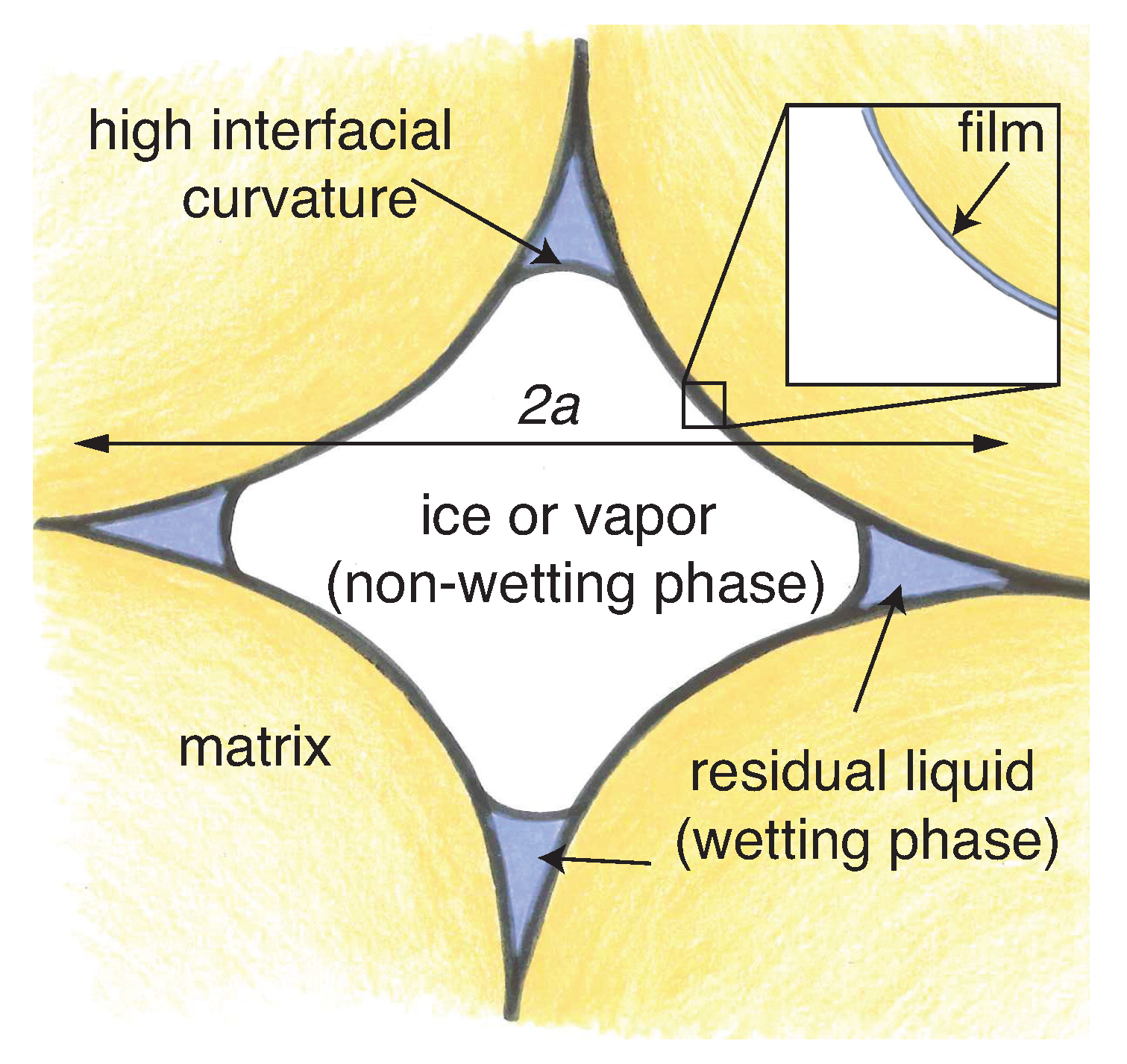


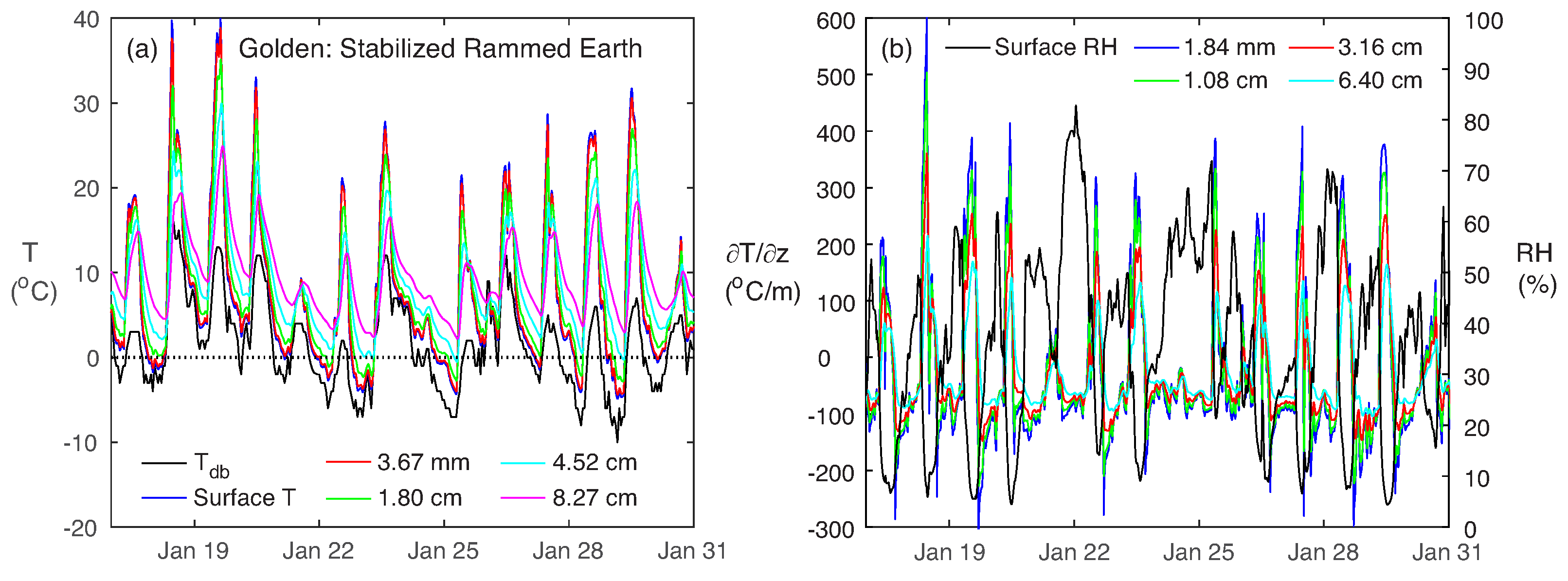
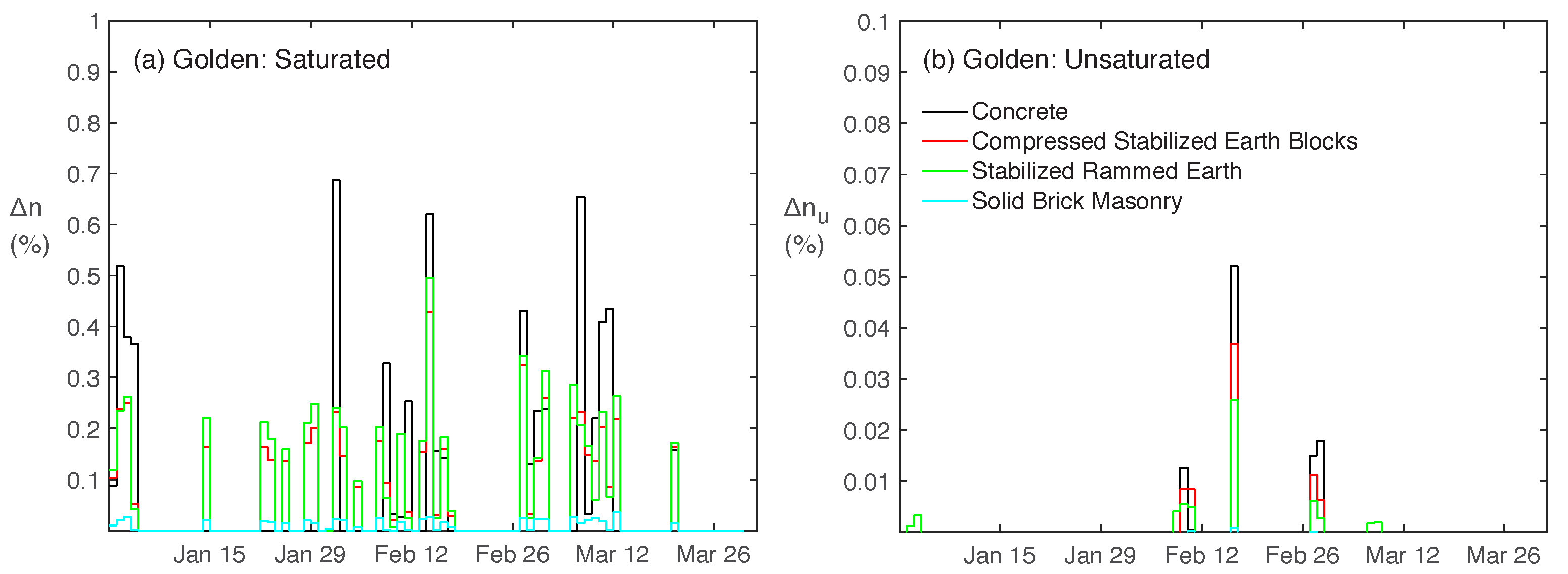
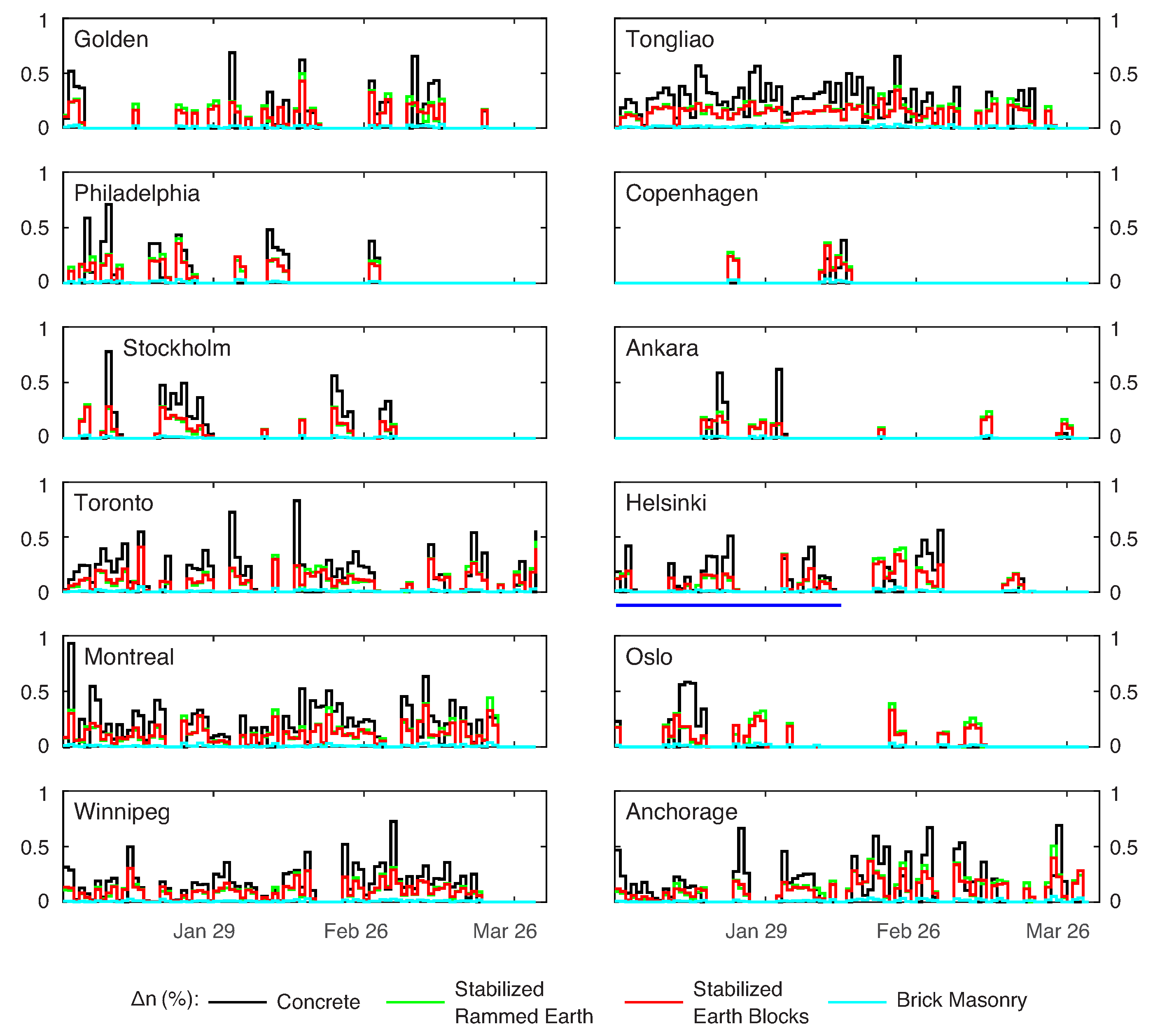



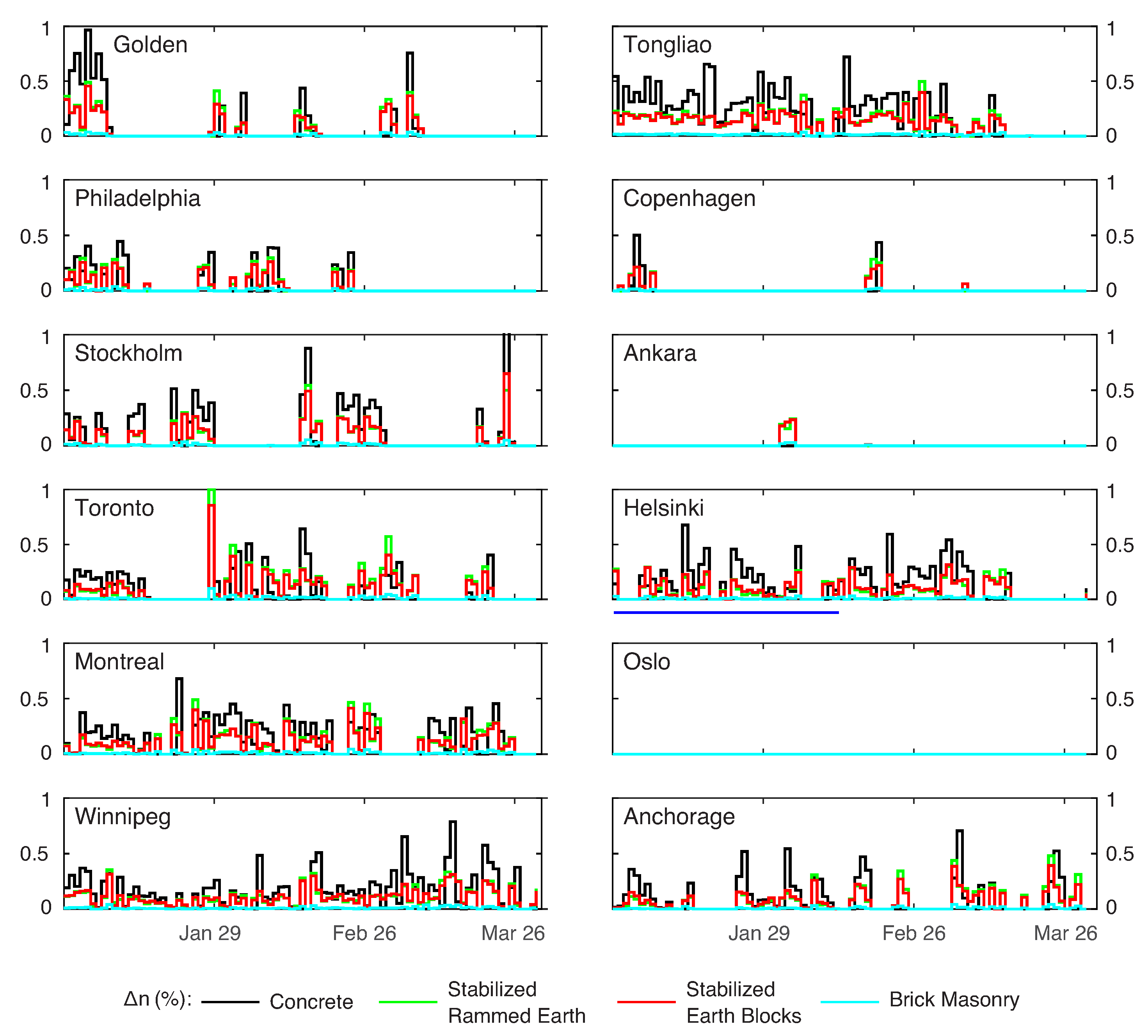


| Property | Stabilized Rammed Earth | Compressed Stabilized Earth Blocks | Solid Brick Masonry | Concrete |
|---|---|---|---|---|
| n | 0.295 | 0.14 | 0.24 | 0.16 |
| (kg m) | 1900 | 1735 | 1900 | 2275 |
| (W m K) | 0.643 | 0.7 e | 0.6 | 1.7 |
| c (J kg K) | 868 | 836 | 850 | 850 |
| 7.6 | 5.9 | 10 | 147 | |
| (K) | 0.40 | 0.15 | 0.44 | 0.85 |
| 0.45 | 0.31 | 0.65 | 0.35 | |
| 3.6 | 2.5 | 5.2 | 2.8 | |
| (C) | ||||
| (m) | ||||
| C (m K day) |
| City | Köppen Climate | Description | Weather File | Years |
|---|---|---|---|---|
| Golden | Cold semi-arid | USA_CO_Golden-NREL.724666_TMY3 | 1991–2005 | |
| grassland | USA_CO_Boulder_HadCM3-A2-2020 | 2020 | ||
| Tongliao | Cold semi-arid | CHN_Nei.Mongol.Tongliao.541350_SWERA | 1975–1999 | |
| grassland | CHN_NM_Tongliao.541350_TMYx.2003-2017 | 2003–2017 | ||
| Philadelphia | Humid | USA_PA_Philadelphia.Intl.AP.724080_TMY3 | 1976–2005 | |
| subtropical | USA_PA_Philadelphia_HadCM3-A2-2020 | 2020 | ||
| Copenhagen | Oceanic | DNK_Copenhagen.061800_IWEC | 1983–1999 | |
| DNK_HS_Copenhagen-Kastrup.AP.061800_TMYx.2003-2017 | 2003–2017 | |||
| Stockholm | Oceanic | SWE_Stockholm.Arlanda.024600_IWEC | 1984–1993 | |
| SWE_ST_Stockholm.Arlanda.AP.024600_TMYx.2003-2017 | 2003–2017 | |||
| Ankara | Mediterranean | TUR_Ankara.171280_IWEC | 1982–1994 | |
| TUR_AN_Ankara.Central.171300_TMYx.2003-2017 | 2003–2017 | |||
| Toronto | Humid | CAN_ON_Toronto.716240_CWEC | 1961–1990 | |
| continental | CAN_ON_Toronto.Pearson.Intl.AP.716240_CWEC2016 | 2016 | ||
| Helsinki | Hemiboreal | FIN_Helsinki.029740_IWEC | 1982–1998 | |
| FIN_US_Helsinki-Vantaa.AP.029740_TMYx.2003-2017 | 2003–2017 | |||
| Montreal | Hemiboreal | CAN_PQ_Montreal.Intl.AP.716270_CWEC | 1961–1990 | |
| CAN_QC_Montreal-Mirabel.Intl.AP.719050_CWEC2016 | 2016 | |||
| Oslo | Hemiboreal | NOR_Oslo.Fornebu.014880_IWEC | 1983–1998 | |
| NOR_OS_Oslo-Fornebu.AP.014881_TMYx.2003-2017 | 2003–2017 | |||
| Winnipeg | Hemiboreal | CAN_MB_Winnipeg.718520_CWEC | 1961–1990 | |
| CAN_MB_Winnipeg-Richardson.Intl.AP.718520_CWEC2016 | 2016 | |||
| Anchorage | Subarctic | USA_AK_Anchorage.Intl.AP.702730_TMY3 | 1975–1999 | |
| USA_AK_ANCHORAGE_HadCM3-A2-2020 | 2020 |
© 2019 by the authors. Licensee MDPI, Basel, Switzerland. This article is an open access article distributed under the terms and conditions of the Creative Commons Attribution (CC BY) license (http://creativecommons.org/licenses/by/4.0/).
Share and Cite
Rempel, A.W.; Rempel, A.R. Frost Resilience of Stabilized Earth Building Materials. Geosciences 2019, 9, 328. https://0-doi-org.brum.beds.ac.uk/10.3390/geosciences9080328
Rempel AW, Rempel AR. Frost Resilience of Stabilized Earth Building Materials. Geosciences. 2019; 9(8):328. https://0-doi-org.brum.beds.ac.uk/10.3390/geosciences9080328
Chicago/Turabian StyleRempel, Alan W., and Alexandra R. Rempel. 2019. "Frost Resilience of Stabilized Earth Building Materials" Geosciences 9, no. 8: 328. https://0-doi-org.brum.beds.ac.uk/10.3390/geosciences9080328





